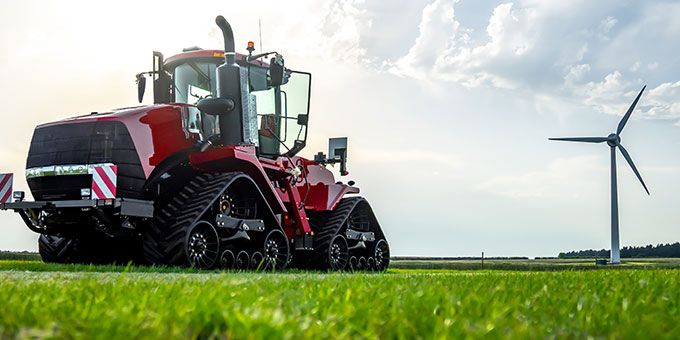Battery technology needs to be developed in order to withstand the heavy loads of agricultural vehicles and supply a lasting and reliable source of power.
 Electrifying Agriculture - How EV Tractors Can Support the Sector’s Sustainable Shift
Electrifying Agriculture - How EV Tractors Can Support the Sector’s Sustainable Shift

Simone Bruckner, managing director | Cressall
The electrification of the on-road transportation sector is well documented. What’s less discussed, however, are the off-road applications that can also benefit from electrification. That includes agricultural equipment. Here, Simone Bruckner, managing director of resistor manufacturer Cressall, explains how the agricultural sector can electrify, and technologies that can help.
According to the UK Government’s Department for Environment, Food, & Rural Affairs’ Agri-climate report 2021, in 2019, agriculture was the source of ten per cent of total greenhouse gas emissions in the UK. The sector was also responsible for 68 per cent of total nitrous oxide emissions, 47 per cent of total methane emissions and 1.7 per cent of total carbon dioxide emissions.
However, despite these figures, it seems the farming community is seeking change. The 2021 Farm Practices Survey indicated that 67 per cent of farmers consider recognising greenhouse gases to be either fairly or very important when taking decisions about their land, crops and livestock. One method of reducing emissions is to electrify equipment that traditionally runs on fossil fuels, such as tractors.
A necessary change
Modern agriculture depends on a fleet of heavy-duty vehicles, from pickup trucks and small utility vehicles to massive tractors and combines that can weigh several tonnes, plus attachments. This machinery is commonly powered by diesel engines, mostly due to their higher torque and dependability. And here is where an electrification challenge may lie.
The electric sceptics of the agricultural industry claim that the largest problem with electrifying tractors and other heavy vehicles is that battery-powered options don’t have the energy density of a diesel model required to do long, hard work in the field. As load impacts on battery life, pulling a piece of heavy equipment would drain power fast. Using diesel, therefore, means a farmer won’t have to worry about filling the tank for 10 to 12 hours while out on the job.
Battery technology, therefore, needs to be developed in order to withstand the heavy loads of agricultural vehicles and supply a lasting and reliable source of power. Some manufacturers have produced compact, swappable batteries to extend the length of operation. Another option, developed by John Deer in 2019, features a long power cable that’s only available for farmers who are able to produce their own electricity via the use of solar panels, manure digesters or windmills.
Right now, despite its challenges, attempts to electrify farming vehicles are well underway. The work is being done, and given the mounting pressure to decarbonise all areas of industry, it won’t be too long before electrification becomes more accessible to the masses. In addition to the battery itself, manufacturers must consider the other components that make electrifying possible.
Dynamic braking
Resistors will play a role in electrification, to support the process of regenerative braking. As part of regenerative braking, excess kinetic energy is used to recharge an EV’s battery. It is able to do this because the electric motor in an EV can run in two directions: one, using the electrical energy, to drive the wheels and move the vehicle, and the other, using the excess kinetic energy, to recharge the battery.
When the driver lifts their foot off the accelerator pedal and steps on the brake, the motor starts to resist the vehicle’s motion, “swapping direction”, and begins putting energy back into the battery. As a result, regenerative braking uses the EV’s motor as a generator to convert lost kinetic energy into stored energy in the battery.
Regenerative braking can support the ongoing dilemma of electric tractor battery range. However, to work effectively, other technologies are needed to make the process safe and effective. If the vehicle’s battery is already full or there is a failure, regenerative braking cannot happen as the excess energy has nowhere to go and must be dispelled safely. If not dissipated, it won’t be possible to slow down the vehicle, resulting in braking failure. To make electrifying agriculture safe, resistors are used to collect excess energy and dissipate it safely.
Cressall’s EV2 dynamic braking resistor converts excess kinetic energy during the braking process into heat that can be dissipated or used in other parts of the vehicle, like to heat the tractor’s cabin. It is a high-power density, lightweight and compact resistor that has proven to meet all major shock and vibration standards, suitable for all automotive applications, not just on-road vehicles.
While electrifying on-road vehicles has become well recognised, the same attention must be paid to other areas of the automotive industry. The agricultural sector is beginning to wake up to the prospects of decarbonising, and positive steps are being taken towards electrification. To make it happen, agricultural vehicle manufacturers need to consider the technology that can make agricultural EVs more efficient, and safer.
To learn more about Cressall’s resistors for agricultural applications, visit www.cressall.com.
The content & opinions in this article are the author’s and do not necessarily represent the views of AltEnergyMag
Comments (0)
This post does not have any comments. Be the first to leave a comment below.
